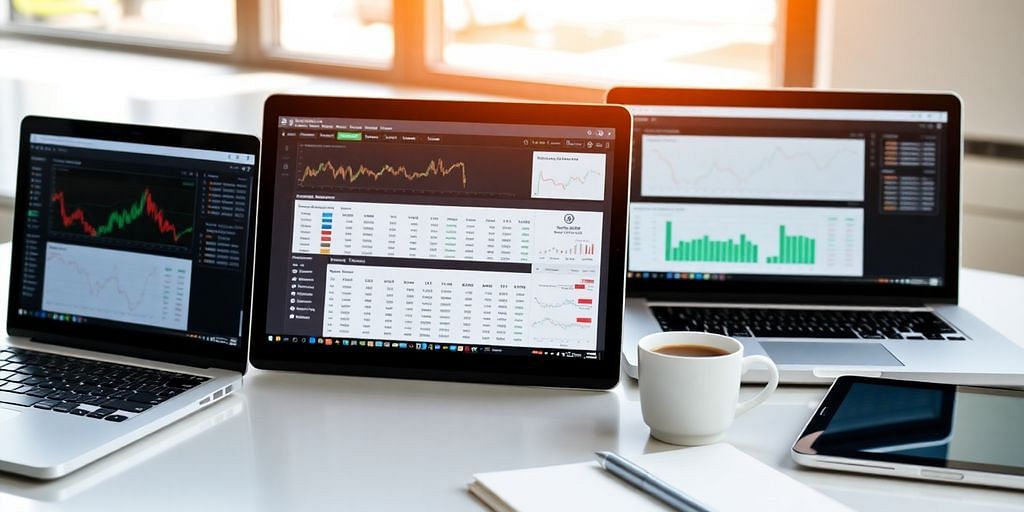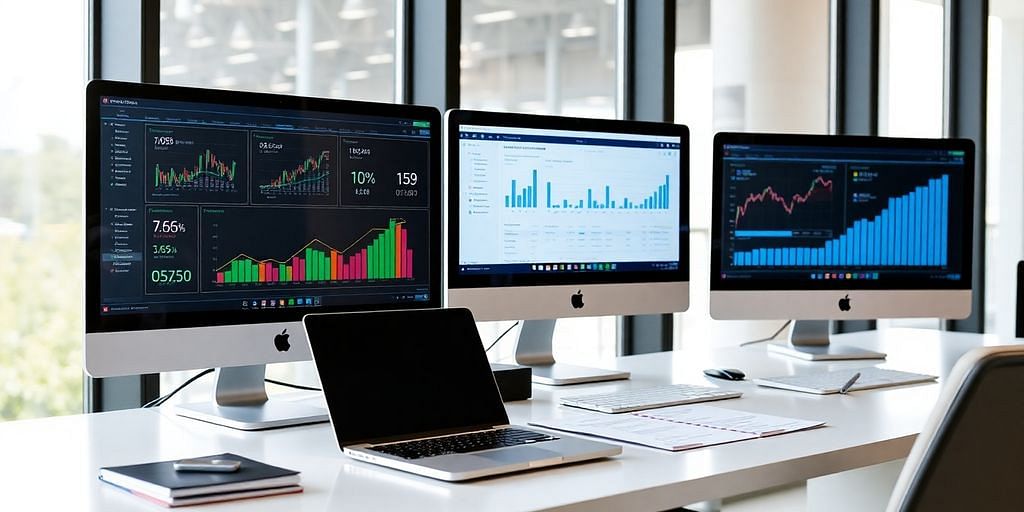
Exploring the Best Financial Software Products for 2025: A Comprehensive Guide
Back To BlogTop Financial Software Products to Watch in 2025

Why These Products Stand Out
Alright, let's dive into the world of financial software for 2025. This year, we're seeing some pretty exciting stuff. These products are not just about crunching numbers; they're about making life easier. Their standout features? Think seamless integration, user-friendly interfaces, and top-notch security. What's really cool is how they bring all your financial data together in one place, making it easier to see the big picture. Plus, they keep everything secure with the latest encryption tech, so you can breathe easy knowing your data's safe.
Key Features to Look For
When it comes to choosing the right software, there are a few key features you want to keep an eye out for:
- User-Friendly Design: No one wants to deal with clunky software. Look for something intuitive.
- Real-Time Updates: It's crucial to have the latest data at your fingertips.
- Comprehensive Security: Encryption, multi-factor authentication, and fraud alerts are must-haves.
How They Can Benefit Your Business
So, how can these tools actually help your business? Well, imagine having all your financial data neatly organized and easily accessible. It means making informed decisions faster and more accurately. For example, discover the top 10 financial statement software options that can enhance efficiency and accuracy in financial reporting. Plus, with automation features, you'll save time on mundane tasks, letting you focus on what really matters—growing your business. And let's not forget, with robust analytics, you can spot trends and make predictions, giving you a competitive edge.
In a nutshell, investing in the right financial software is like having a trusty sidekick that keeps your business running smoothly while you focus on the big picture.
So, there you have it. Keep an eye on these features and benefits as you explore the best financial software for your needs in 2025.
Integrating Financial Software into Your Business
Steps to Seamless Integration
Alright, folks, let's get into the nitty-gritty of integrating financial software with your existing systems. First off, understanding your current setup is crucial. You need to know what tools you're already using and how they communicate with each other. Are they playing nice, or are they more like cats and dogs? Once you've got that down, it's time to pick the right software. Selecting accounting software that integrates smoothly with existing business tools like CRM systems, inventory management, and payment gateways is crucial for streamlined operations and enhanced efficiency.
Here's a quick rundown to get you started:
- Assess Your Needs: What do you really need from your financial software? Make a list.
- Check Compatibility: Ensure the new software works well with your existing systems.
- Plan the Integration: Set a timeline and assign roles. Who's doing what?
Common Challenges and Solutions
Integration isn't always a walk in the park. You might face issues like data mismatches or system downtime. But don't sweat it. Most of these problems have straightforward fixes.
- Data Mismatches: Double-check your data formats and make sure everything's aligned.
- System Downtime: Schedule integrations during off-peak hours to minimize disruptions.
- User Training: Make sure your team knows how to use the new system effectively.
"Integration is all about making your systems talk to each other. When they do, everything just flows better."
Maximizing Interoperability
Interoperability is the name of the game here. Your software should be able to communicate with other systems effortlessly. This means looking for tools that offer robust API support and can easily connect with your existing tech stack.
- Flexibility: Choose software that can adapt as your business grows.
- Scalability: Ensure it can handle increased data as your business expands.
- Support: Opt for vendors who offer solid customer support to troubleshoot any issues.
Remember, the goal is to create a harmonious tech environment where everything works together seamlessly. With the right approach, integrating financial software can be a game-changer for your business.
Security and Compliance in Financial Software

Essential Security Features
When it comes to financial software, security is not just a feature—it's a necessity. Think of it as the backbone of trust. We need to ensure that every transaction and piece of data is safe from prying eyes. Here are some key security features to consider:
- Multi-factor Authentication (MFA): This adds an extra layer of security, making it harder for unauthorized users to gain access.
- End-to-End Encryption: Ensures that data is protected as it travels from sender to receiver, keeping it safe from interception.
- Real-time Fraud Detection: This feature helps identify suspicious activities instantly, allowing for quick action to prevent fraud.
In today's digital world, protecting your financial data is like locking your front door—it's just common sense.
Compliance with Industry Standards
Staying compliant with industry standards is a must for any financial software. It's not just about following rules; it's about maintaining trust and avoiding hefty fines. We need to keep up with regulations like GDPR, PCI DSS, and anti-money laundering laws, which can change faster than we can keep track. Here's how we can manage compliance:
- Regular Audits: Conducting regular checks ensures that the software meets all current standards.
- Automated Compliance Updates: Using software that automatically updates compliance protocols can save time and reduce errors.
- Training and Awareness: Keeping everyone informed about the latest regulations helps maintain compliance across the board.
Protecting Your Data
Data protection is at the heart of financial software security. We can't afford to be lax when it comes to safeguarding sensitive information. Here are some strategies we can use:
- Data Masking: This technique hides sensitive data by obscuring it with random characters, making it useless if intercepted.
- Secure APIs: Using secure Application Programming Interfaces (APIs) ensures that data exchanges between systems are safe.
- Access Controls: Implementing strict access controls ensures that only authorized personnel can view or manipulate sensitive data.
In 2025, financial services will prioritize application modernization, enhance data governance for AI, strengthen cyber resilience, and ensure regulatory compliance. Keeping these priorities in mind will help us stay ahead in the ever-evolving landscape of financial software security and compliance.
Choosing the Right Financial Software for Your Needs
Assessing Your Business Requirements
Before diving into the world of financial software, let's take a step back and figure out what we really need. It’s kinda like shopping for groceries—you don’t want to buy stuff you won’t use. Understanding your business requirements is crucial. Start by asking yourself:
- What are the main financial tasks you need help with? Are you looking for something to manage expenses, track investments, or handle payroll?
- How big is your team, and how tech-savvy are they?
- Do you need something that integrates with existing systems like CRM or inventory management?
Once you have a clear picture, you can narrow down your options and focus on what truly matters.
Comparing Different Software Options
Now that we have our list of needs, it’s time to compare the options out there. Think of it like choosing between Quicken Deluxe for detailed budgeting or the Empower Personal Dashboard for investment tracking. Here's a simple way to break it down:
- Features: Does the software offer what you need? Some tools are great for budgeting, while others shine in tax management.
- Ease of Use: Can your team use it without a Ph.D. in computer science?
- Cost: Is it within your budget? Remember, sometimes you get what you pay for.
You might even want to create a table to compare these factors:
Making the Final Decision
Alright, we’ve assessed our needs and compared options. Now, it’s decision time. But don’t rush it. Consider:
- Trial Runs: Many software products offer free trials. Use these to see if the software feels right.
- Feedback: Talk to your team. They’re the ones who’ll be using it daily.
- Future Needs: Will this software grow with your business, or will you outgrow it in a year?
Remember, choosing the right software is like picking the right pair of shoes—it needs to fit well and support you as you walk, run, or even sprint toward your business goals.
Take your time, weigh your options, and go with what feels right. Happy software hunting!
Frequently Asked Questions
What is financial software?
Financial software is a computer program that helps manage money tasks like budgeting, tracking expenses, and planning finances for businesses or personal use.
Why is security important in financial software?
Security is crucial because it keeps your financial information safe from hackers and unauthorized access, protecting your money and personal details.
How do I choose the right financial software for my business?
To pick the right software, think about your business needs, compare different options, check features, and make sure it fits your budget.
